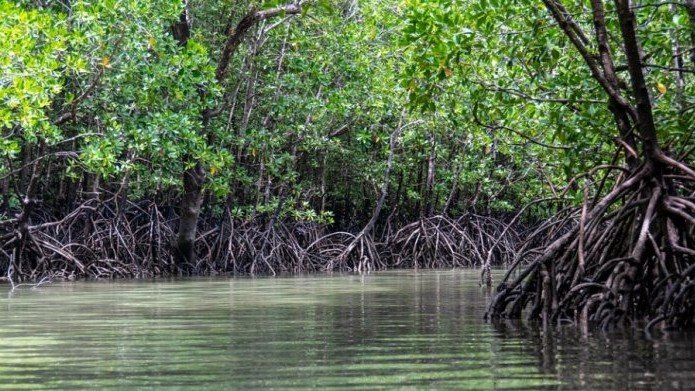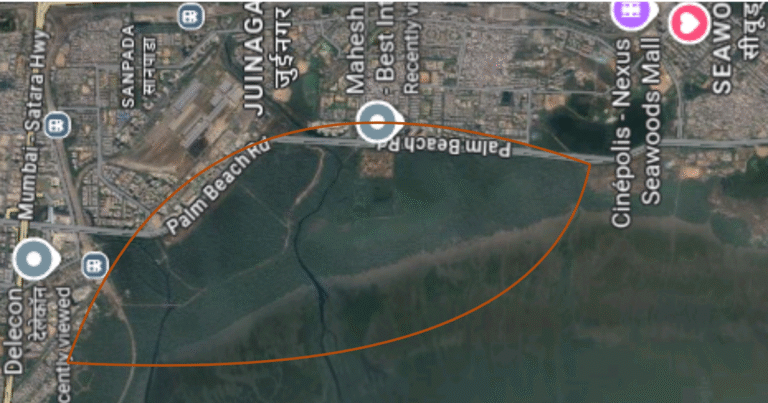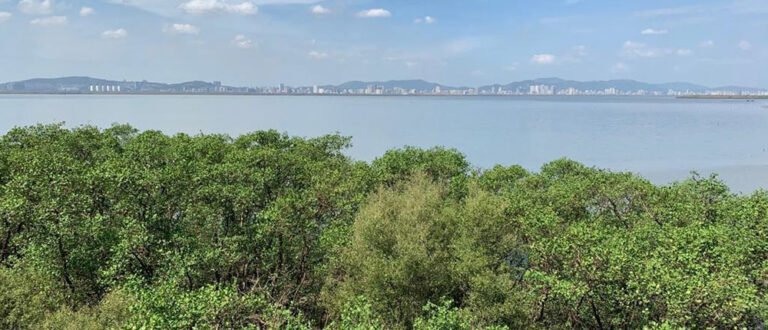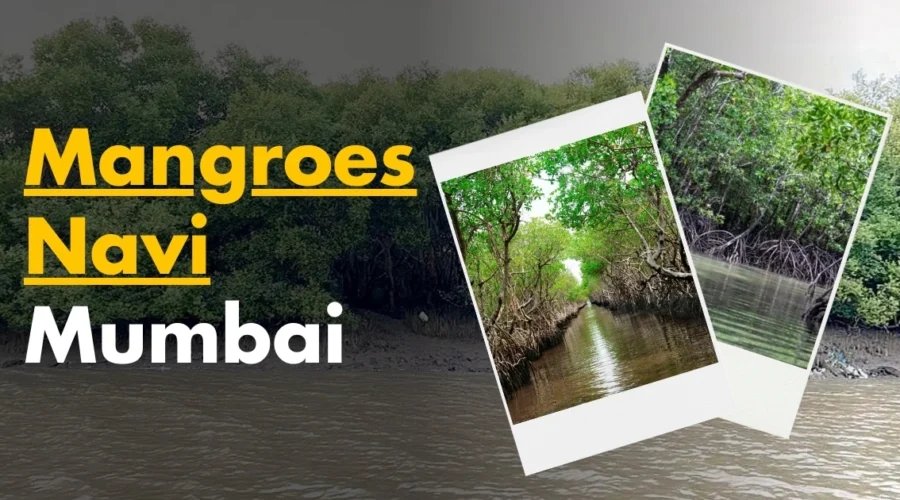Mangroves in Navi Mumbai: Importance, Threats & Conservation
Have you ever walked along the coast and noticed those unique trees that seem to grow right out of the water? These are called mangroves, and in places like Mangroves in Navi Mumbai, they’re truly remarkable! These trees can actually grow in super-salty water. Mangroves are specialized with unique adaptations that help them survive in such challenging environments. One of their most curious features is their root system. Instead of the typical downward-growing roots seen in most trees, many mangrove species develop aerial roots that extend above the ground. These roots, aptly called “prop roots,” look like stilts, supporting the trees from sinking into the soft, muddy surface and allowing them to withstand violent tides and waves.
Mangroves: Nature’s Resilient Coastal Guardians
By definition, mangroves are a varied group of salt-tolerant trees and shrubs growing in intertidal regions along tropical and subtropical coastlines. The sturdy root systems allow them to anchor in the shifting, flowing sands and mudflats, and in this manner offer a unique habitat for a rich variety of flora and fauna.
Mangroves Under Threat Again: Navi Mumbai

The environment in Navi Mumbai is set to take another hard blow as six more acres of mangrove forests are set to be cut down for easier access to the airport that is yet to come up. This has happened after the government had earlier set 500 acres of mangroves to be cleared for the airport project.
To streamline access to the airport, the City Industrial Development Corporation justifies the need for the construction of more bridges and the removal of a dam on the Moha River. While the MCZMA has already given the nod, it imposed some conditions. It requires CIDCO to plant five times the number of mangroves cut and avoid harm to water bodies during construction.
This decision raises eyebrows as to its long-term consequences for Navi Mumbai’s fragile coastal ecosystem. Mangroves are extremely important for protecting shorelines from erosion and for providing habitat for marine and terrestrial wildlife and for climate change mitigation.
Why are Mangroves Important?
- They protect our shorelines: Like a sturdy wall, the mangroves prevent the crashing of huge sea waves onto the beach during storms.
- They’re home to many animals: From small crabs to stunning birds, mangroves provide all creatures with a safe home.
- They clean water: Mangroves act as natural filters that help maintain the cleanliness and health of ocean waters.
- They fight climate change: Like sponges, mangroves absorb harmful gases from the air.
The Significance of Mangroves in Navi Mumbai
- Coastal Shield: Mangroves are the natural wave barriers, reducing the erosion of the coastline, high tides, and tsunami. Their dense covering of roots dissipates wave energy thus reducing the impact of hazards to coastal line.
- Biodiversity Hotspots: These unique ecosystems afford an extraordinary array of life. Mangroves furnish critical habitats for large populations of fishes, birds, invertebrates, and many other wildlife.
- Carbon Sinks: Mangroves are extremely good carbon sinks; they capture and store large volumes of CO2 from the atmosphere and thus mitigate climate change.
- Water Quality Improvement: Mangrove forests function like natural water filters by stabilizing sediment and trapping pollutants ahead; thus they improve water quality for the coastal surrounding areas.
Several laws and Acts in India that Protect Mangroves:
- Indian Forest Act, 1927: Though not targeted at mangroves, the act gives a very broad structure for the forest conservation plan, including mangrove forests when most of them are typically included under forest land.
- Wildlife (Protection) Act, 1972: It provides protection to several species of plants/animals in mangrove ecosystems.
- Environment (Protection) Act, 1986: This act made the Coastal Regulation Zone (CRZ) notification, which regulates activities in coastal areas, including mangrove zones, in view of protecting the fragile coastal environment.
- Mangrove Forests (Special Provisions) Act, 2019: A newer and more specific act to protect, develop, and afforest mangroves, establishing a National Board for the development of mangrove forests and providing for the proper use of dry wood coming from mangroves.

Mangroves in Navi Mumbai
Navi Mumbai is lucky to have these amazing mangrove forests. They grow along the Thane Creek, creating a beautiful green belt.
- Vashi: Mangroves can be found in several areas within Vashi, often along the edges of the creek or near water bodies.
- Belapur: Significant mangrove patches exist within Belapur, particularly along the creek and near coastal areas.
- Airoli: Mangroves are present in Airoli as well, though the extent may vary.
Latest news on Mangroves of Navi Mumbai
A total of 1,200 kg of trash was cleared from the Nerul mangroves during a cleanup drive organized by environmental groups and local volunteers. The initiative aimed to reduce plastic and solid waste choking the mangrove ecosystem.
(Source: Newsband, July 27, 2025)
Navi Mumbai residents have raised strong concerns over the destruction of mangroves and tree cover in buffer zones due to ongoing construction activities. Citizens met with Minister Ganesh Naik to demand immediate action against illegal dumping and encroachments.
(Source: The Indian Express, March 12, 2025)
Mangroves in Navi Mumbai: Locations & Significance
- Online Resources: Through Google Maps or other online mapping programs, search for mangroves or mangrove forests in Navi Mumbai. This search may bring some locations or a few areas of higher concentration of mangroves into light.
- Local Environmental Organizations: Reach out to local environmental organizations or NGOs active in Navi Mumbai. They may have real-time, detailed information from their workings on the accessible mangrove areas, guided walks, and any conservation initiatives.
- Local Inquiries: Ask local residents, shopkeepers, or nature enthusiasts in Navi Mumbai for directions and also advice.
Important Note:
When visiting any mangrove area, please be mindful of the environment. Stay on designated trails, avoid disturbing the wildlife, and dispose of any trash responsibly.

Challenges for Mangroves:
- Pollution: In some cases, the dumping of contaminated water from factories and homes would threaten mangroves.
- Construction: Construction of new housing and roads destroys mangrove habitats.
- Climate Change: As the Earth warms, the rising ocean levels may drown the mangroves.
What can we do to help?
- Do not litter: Keep your beaches clean! Dispose of trash neatly.
- Conserve water: It helps to keep our oceans healthy.
- Support organizations that protect mangroves: Many organizations work hard to save these important trees.
Together, let’s make sure that mangroves in Navi Mumbai survive for generations!
Conservation Efforts
- Government regulations: Many countries are having some laws and orders to safeguard mangrove ecosystems, including the identification of protected areas and restrictions on development activities in coastal zones.
- Community involvement: Local communities and NGOs are very active in various activities in mangrove conservation, awareness campaigns, clean-up drives, and participation in some mangrove restoration projects.
A Call to Action
Protecting and restoring mangrove ecosystems is essential for the long-term health of Navi Mumbai. We can all play a part in this effort by:
- Reducing Pollution: Cutting down on plastic waste, properly managing sewage disposal, and encouraging sustainable consumption habits. Supporting
- Conservation Initiatives: Getting involved in mangrove restoration projects, backing local NGOs, and pushing for stronger environmental regulations.
- Raising Awareness: Learning about the significance of mangroves and the challenges they face, and sharing this knowledge with others.
By coming together, we can help ensure that the lush guardians of Navi Mumbai continue to flourish for future generations.
Conclusion
Mangroves are essential ecosystems that offer invaluable services to our planet. They shield coastlines, foster biodiversity, and are key players in the fight against climate change. Unfortunately, these remarkable ecosystems are under serious threat from human activities. To protect mangroves for future generations, conservation efforts such as establishing protected areas, engaging communities, and promoting sustainable practices are vital.
FAQ's
Frequently Asked Questions
How can we protect mangroves?
Through conservation efforts like protected areas, community involvement, and sustainable practices.
What is special about mangrove trees?
Mangroves provide natural infrastructure to help protect nearby populated areas by reducing erosion and absorbing storm surge impacts during extreme weather events such as hurricanes
What are the threats to mangroves?
Coastal development, pollution, and climate change pose significant threats.




